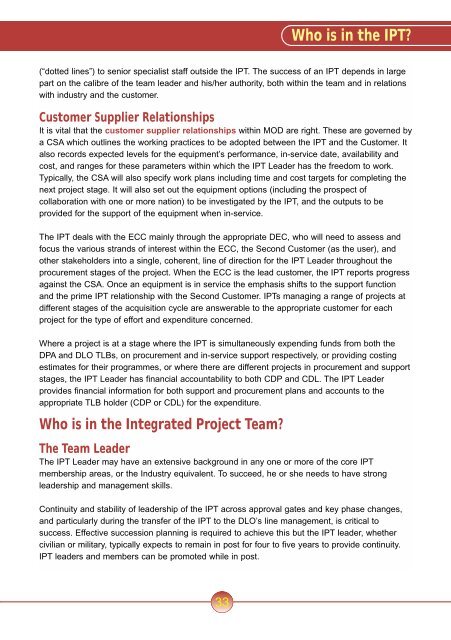The Acquisition Handbook
The Acquisition Handbook
The Acquisition Handbook
- No tags were found...
You also want an ePaper? Increase the reach of your titles
YUMPU automatically turns print PDFs into web optimized ePapers that Google loves.
Who is in the IPT?(“dotted lines”) to senior specialist staff outside the IPT. <strong>The</strong> success of an IPT depends in largepart on the calibre of the team leader and his/her authority, both within the team and in relationswith industry and the customer.Customer Supplier RelationshipsIt is vital that the customer supplier relationships within MOD are right. <strong>The</strong>se are governed bya CSA which outlines the working practices to be adopted between the IPT and the Customer. Italso records expected levels for the equipment’s performance, in-service date, availability andcost, and ranges for these parameters within which the IPT Leader has the freedom to work.Typically, the CSA will also specify work plans including time and cost targets for completing thenext project stage. It will also set out the equipment options (including the prospect ofcollaboration with one or more nation) to be investigated by the IPT, and the outputs to beprovided for the support of the equipment when in-service.<strong>The</strong> IPT deals with the ECC mainly through the appropriate DEC, who will need to assess andfocus the various strands of interest within the ECC, the Second Customer (as the user), andother stakeholders into a single, coherent, line of direction for the IPT Leader throughout theprocurement stages of the project. When the ECC is the lead customer, the IPT reports progressagainst the CSA. Once an equipment is in service the emphasis shifts to the support functionand the prime IPT relationship with the Second Customer. IPTs managing a range of projects atdifferent stages of the acquisition cycle are answerable to the appropriate customer for eachproject for the type of effort and expenditure concerned.Where a project is at a stage where the IPT is simultaneously expending funds from both theDPA and DLO TLBs, on procurement and in-service support respectively, or providing costingestimates for their programmes, or where there are different projects in procurement and supportstages, the IPT Leader has financial accountability to both CDP and CDL. <strong>The</strong> IPT Leaderprovides financial information for both support and procurement plans and accounts to theappropriate TLB holder (CDP or CDL) for the expenditure.Who is in the Integrated Project Team?<strong>The</strong> Team Leader<strong>The</strong> IPT Leader may have an extensive background in any one or more of the core IPTmembership areas, or the Industry equivalent. To succeed, he or she needs to have strongleadership and management skills.Continuity and stability of leadership of the IPT across approval gates and key phase changes,and particularly during the transfer of the IPT to the DLO’s line management, is critical tosuccess. Effective succession planning is required to achieve this but the IPT leader, whethercivilian or military, typically expects to remain in post for four to five years to provide continuity.IPT leaders and members can be promoted while in post.33
















